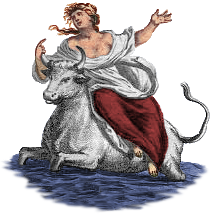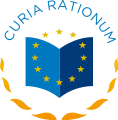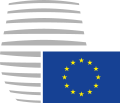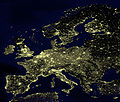Portal:European Union
Introduction
The European Union (EU) is a supranational political and economic union of 27 member states that are located primarily in Europe. The Union has a total area of 4,233,255 km2 (1,634,469 sq mi) and an estimated total population of over 449 million. The EU has often been described as a sui generis political entity combining the characteristics of both a federation and a confederation. Containing 5.8% of the world population in 2020, EU member states generated a nominal gross domestic product (GDP) of around US$16.6 trillion in 2022, constituting approximately one sixth of global nominal GDP. Additionally, all EU states except Bulgaria have a very high Human Development Index according to the United Nations Development Programme. Its cornerstone, the Customs Union, paved the way to establishing an internal single market based on standardised legal framework and legislation that applies in all member states in those matters, and only those matters, where the states have agreed to act as one. EU policies aim to ensure the free movement of people, goods, services and capital within the internal market; enact legislation in justice and home affairs; and maintain common policies on trade, agriculture, fisheries and regional development. Passport controls have been abolished for travel within the Schengen Area. The eurozone is a group composed of the 20 EU member states that have fully implemented the economic and monetary union and use the euro currency. Through the Common Foreign and Security Policy, the union has developed a role in external relations and defence. It maintains permanent diplomatic missions throughout the world and represents itself at the United Nations, the World Trade Organization, the G7 and the G20. Due to its global influence, the European Union has been described by some scholars as an emerging superpower. In 2012, the EU was awarded the Nobel Peace Prize. The United Kingdom became the only member state to leave the EU, in 2020; ten countries are aspiring or negotiating to join it. (Full article...) Selected article The Maserati MC12 is a grand tourer produced by Maserati to allow a racing variant to compete in the FIA GT Championship. The car entered production in 2004 with 25 cars produced. A further 25 were produced in 2005 making a total of 50 cars available for customers, all of which were pre-sold for €600 000. Maserati designed and built the car on the chassis of the Enzo Ferrari but the final car is much larger. The MC12 is longer, wider and taller than the Enzo Ferrari, however the Enzo has faster acceleration and a higher top speed. The MC12 was developed to signal Maserati's return to racing after 37 years. The road version was produced to homologate the race version. One of the requirements for participation in the FIA GT is the production of at least 25 road cars. Three GT1 race cars were entered into the FIA GT with great success. Maserati began racing the MC12 in the FIA GT toward the end of the 2004 season, achieving a victory at the Zhuhai International Circuit. Selected pictureMap credit: Olaus Magnus The carta marina is the earliest detailed map of the Nordic countries. It took twelve years to finish and the first copies were printed in 1539 in Venice. Its existence had long been considered apocryphal, until a copy was discovered in Munich in 1886. The map is divided in 3×3 sheets with the dimension 55x40 cm (22x16 in), each made from a separate woodcut block. Historia de gentibus septentrionalibus (Rome, 1555) is a much larger commentary on the map.
Did you know?...that France possesses the largest exclusive economic zone (EEZ) in the world? ...that Monaco, San Marino, and Vatican City all mint their own euro coins, with their own national symbols on the back? ...that Turkey's two most famous weightlifters, Naim Suleymanoglu and Halil Mutlu are only two of four weightlifters in the world to have won 3 gold medals in 3 olympics? Selected cityNicosia, known locally as Lefkosia is the capital and largest city of Cyprus. Nicosia is located at 35°10' north, 33°21' east (35.1667, 33.35). Located on the Pedieos river and situated roughly in the centre of the island, it is the seat of government as well as the main business centre. Nicosia is the center and capital of an administrative district (Nicosia District), and after the fall of the Berlin Wall, it is currently the only divided capital city in the world, with the northern (Turkish) and southern (Greek) portions divided by the "Green Line", a demilitarized zone maintained by the United Nations. The 1974 Turkish invasion and occupation of 36 percent of the island's territory literally cut the capital in half. The population of the part of the city under the control of the Republic of Cyprus is 206,200 (end of 2001). Nicosia is a modern, dynamic capital with lots of shops, restaurants and entertainment.The city is a trade center and manufactures textiles, leather, pottery, plastic, and other products. Copper mines are nearby. Nicosia is the seat of the University of Cyprus (UCY) and of all the colleges and institutes of Republic of Cyprus. General imagesThe following are images from various European Union-related articles on Wikipedia.
TopicsFeatured contentFeatured articles
Featured lists
Featured contentGood articles
CategoriesRelated portalsAssociated WikimediaThe following Wikimedia Foundation sister projects provide more on this subject:
Discover Wikipedia using portals |































































